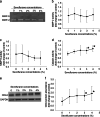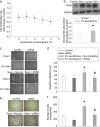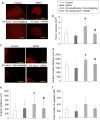Sevoflurane promotes migration, invasion, and colony-forming ability of human glioblastoma cells possibly via increasing the expression of cell surface protein 44
- PMID: 30967592
- PMCID: PMC6889382
- DOI: 10.1038/s41401-019-0221-0
Sevoflurane promotes migration, invasion, and colony-forming ability of human glioblastoma cells possibly via increasing the expression of cell surface protein 44
Abstract
Surgical resection of primary solid tumor under anesthesia remains a common practice. It has been concerned whether general anesthetics, especially volatile anesthetics, may promote the growth, migration, and invasion of cancer cells. In this study, we examined the effects of sevoflurane on human glioblastoma cells and determined the role of cluster of differentiation (CD) 44, a cell surface protein involved in cell growth, migration, and invasion, in sevoflurane's effects. We showed that exposure to 1%-4% sevoflurane did not change the cell proliferation, but concentration-dependently increased the invasion of human glioblastoma U251 cells. Furthermore, 4% sevoflurane significantly increased the migration and colony-forming ability of U251 cells. Similar results were observed in human glioblastoma A172 cells. Exposure to sevoflurane concentration-dependently increased the activity of calpains, a group of cysteine proteinases, and CD44 protein in U251 and A172 cells. Knockdown of CD44 with siRNA abolished sevoflurane-induced increases in calpain activity, migration, invasion, and colony-forming ability of U251 cells. Inhalation of 4% sevoflurane significantly increased the tumor volume and invasion/migration distance of U87 cells from the tumor mass in the nude mice bearing human glioblastoma U87 xenograft in the brain. The aggravation by sevoflurane was attenuated by CD44 silencing. In conclusion, sevoflurane increases the migration, invasion, and colony-forming ability of human glioblastoma cells in vitro, and their tumor volume and invasion/migration in vivo. Sevoflurane enhances these cancer cell biology features via increasing the expression of CD44.
Keywords: CD44; anesthetics; calpains; colony forming; human glioblastoma; invasion; migration; sevoflurane.
Conflict of interest statement
The authors declare no competing interests.
Figures








References
-
- Benzonana LL, Perry NJ, Watts HR, Yang B, Perry IA, Coombes C, et al. Isoflurane, a commonly used volatile anesthetic, enhances renal cancer growth and malignant potential via the hypoxia-inducible factor cellular signaling pathway in vitro. Anesthesiology. 2013;119:593–605. doi: 10.1097/ALN.0b013e31829e47fd. - DOI - PubMed
MeSH terms
Substances
Grants and funding
LinkOut - more resources
Full Text Sources
Medical
Miscellaneous

